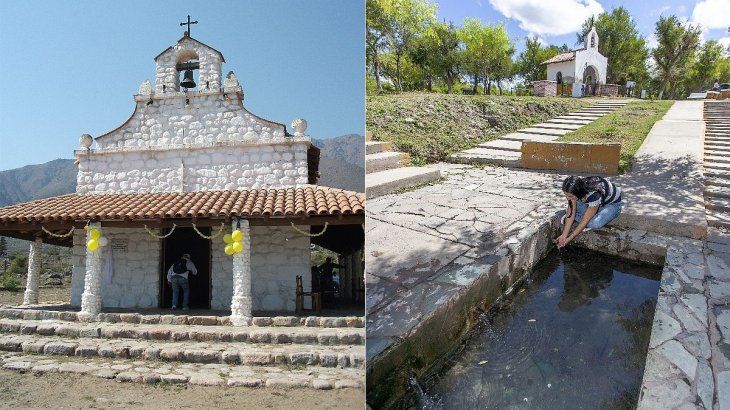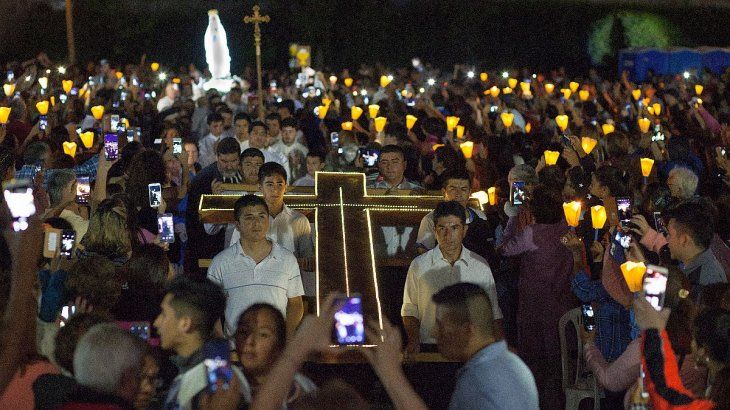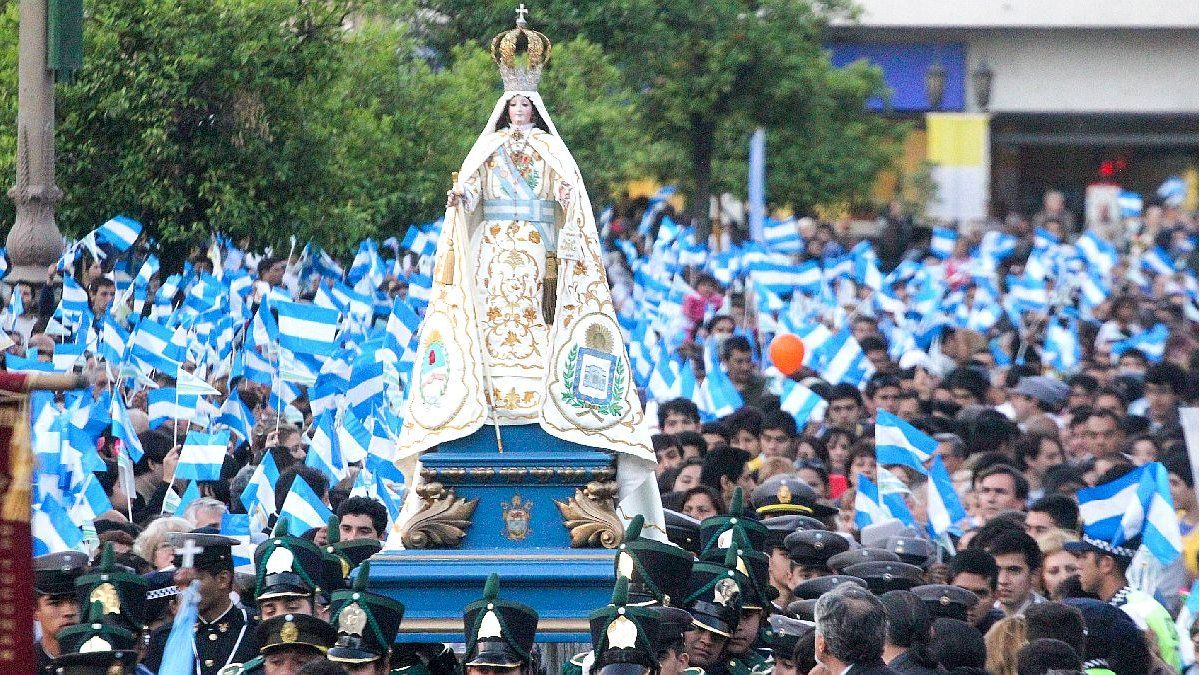“In the middle of the battlefield, an event happens that transcends as a miracle. It is the invasion of locusts that covered the invaders, thus obstructing the vision of the Spanish. And it was then that the Northern Army, led by Belgrano, expelled the royalists under the command of Pío Tristán.”, Synthesizes Maccio and adds that from there, Belgrano attributes to the Virgin having interceded in the battle, and when he returns from fighting, in the middle of the procession, he approaches the image of the Virgin of Mercy, hands her the Staff of Command, and appoints her General of the Northern Army.
For those who like to dive into history, Maccio highlights that the current Plaza Manuel Belgrano in the Tucuman capital, where today the Children’s Hospital is located, was the true and original field of the Battle of Tucumán. In addition, they called him “La Ciudadela” or “Campo de las Carreras” because it was a field where quadreras races were run, Creole skills challenges that at that time were run between two or more riders, for a block – about 129 meters, a unit of measurement during colonial times.
Tucuman Plaza Belgrano.jpg
Since November 1, 2021, Tucumán has 14 weekly flight frequencies from Buenos Aires, from Córdoba and from Puerto Iguazú, Misiones.
This territory of Tucumán, during the years of struggle for Independence, what is known today as a province, belonged at that time to the Great North which also included part of the current provincials of La Rioja, Córdoba, Catamarca, Salta, Santiago del Estero and Jujuy, which formed a region where religious stories are carved since the 16th century, with the arrival of the Spanish and the different religious orders among others, the Jesuits, Dominicans, Franciscans, to evangelize.
“There are stories in every step through Tucumán”, says Gustavo Maccio, who visited “Lules” days ago, one of the cities of the South Circuit of Tucumán, where there are also historical religious sites such as San José de Lules, where the reduction of the Lules Indians was established, founded by the company of Jesus in 1670 and where a school operated and sugar cane was cultivated for the first time.
The sanctuary of the Virgen del Valle, in the town of La Reducción, summons thousands of faithful when December 8, the day of the Immaculate Conception of the Virgin, approaches., in times without a pandemic, while the Our Lady of La Merced Church, dating from the 19th century and located in Villa de Medinas, houses the oldest image of the Virgin of Mercy, sculpted and carved in semi-hard wood, with a gold leaf dating from the year 1600. Every July 15, the coronation of the Virgin is commemorated and the faithful congregate to renew the vows of Faith, and every September 24, the Day of the Virgin of Mercy, it is also a date that unites the parishioners.
Tucuman Virgen de la Merced.jpg

The Virgen de la Merced has several images, one of them in the south of the province with a 16th century carving.
EATT
It should be remembered that the first capital city was founded in 1565, on the site of Ibatín, where Monteros is today, another of the towns on this tour of the South of Tucumán, where the lands were given as a means of payment to Captain Espinoza, a devotee of the Virgin of Rosario, and in her honor he built the chapel of adobe and straw. There, in 1719, for three days, the image sweated by wetting its clothes, an episode that was considered a Miracle of the Virgin.
In every corner of Tucumán stories and miracles are known. From San Francisco Solano, who at the end of the 16th century traveled the region, until the Cura Gaucho, the Father Brochero (1840-1914), sanctified by the Pope Francisco In 2016, they have raised hope in a town that carved Independence.
So much so that episodes that transcended are remembered as when on the site called “Well of the Fish”, about 3 kilometers from Trancas, the thirsty and hungry inhabitants could not keep up until San Francisco Solano placed his cane on the ground and a spring of pure water and fish sprouted, solving the thirst and hunger of the inhabitants.
Tucuman Virgin of Covadonga Chapel El Mollar and Pozo del Pescado.jpg

The Virgen de Covadonga Chapel of El Mollar and Pozo del Pescado, in Tucumán.
EATT
“The miracle of when San Francisco Solano was going to Santiago del Estero is also remembered and when he encountered the swollen river, he withdrew to pray and then approached the shore and signaled to continue his journey. To the amazement of all, the waters opened and from there the river took the name of Río Hondo “, the official described.
Other historical chapters place San Francisco Solano in the heart of the city of San Miguel, at the end of the 16th century, when during a day when they were dealing with bulls, one of the beasts escaped down a street, the same one on which he was walking San Francisco Solano who, seeing him and facing the amazement of the people, waited for him with his hand raised, a gesture that imposed tranquility on the animal that adopted a servile posture while the Father, with the Franciscan cord that he wore in his habits, held him and led him again to his corral. This miracle is represented in the work of the Sevillian painter Bartolomé Esteban Murillo (1610-1682) and is in the city of origin as Royal National Heritage, at Alcazar of Seville, Spain.
Tucumán Procession of the Virgin of Lourdes in San Pedro de Colalao.jpg

Procession of the Virgin of Lourdes in San Pedro de Colalao.jpg
EATT
There are great coincidences in the facts of history and miracles, when it is also remembered that around 1950, a man from Asturias (Spain), which survived an accident, in a show of gratitude and devotion, promised the Virgin of Covadonga to build a place of worship in her honor, on the condition that the place be similar to the lands of Asturia and, it was thus who builds a Church in the town of El Mollar close to Tafí del Valle, in the Calchaquíes valleys in Tucumán where the Virgin of Covadonga (whose translation is Our Lady of the Cave), Maccio pointed out.
Tucumán is a land that offers a wide range of Catholic religious sites, especially the Mariana (Devotees of the Virgin Mary) despite the fact that Jews, Buddhists, people with different creeds and religions that make up the cultural mix of the region also settled on this soil.
Tucuman Ruina de Lules and San Isidro de Lules church.jpg

San isidro de Lules Church, one of the cities of the South Circuit of Tucumán.
EATT
The Route of Faith in the province of Tucumán invites you to visit Temples, Churches, Cathedrals, Basilicas, Museum of Sacred Art, Grottos and Hermitages existing in the different destinations of the province. Every day, month and year, in the calendar of religious events, the faithful renew their faith and devotion and in this pandemic 2021, it will also be possible to celebrate the Virgen de la Merced who, in this context, will visit each neighborhood of the city .
Devotees, believers, faithful, pilgrims and visitors who are interested in history and culture, are part of the universe that on each tour of the territory of Tucumán discover the greatest treasures of this town: its history and its culture.
This tourist segment in the whole world represents some 300 million faithful who travel and visit the places where the Faith is expressed, and this province was the host in 2016 of the First International Congress of Sanctuaries and Religious Tourism and Argentine Meeting of Religious Tourism.
CALENDAR OF EVENTS OF RELIGIOUS TOURISM IN TUCUMÁN
San Miguel de Tucumán:
- The Passion – Holy Week – Parque 9 de Julio.
- Feast of San Cayetano – August 07.
- Feast of San Roque – August 16.
- Feast of the Virgin of La Merced – September 24.
Yungas:
- Holy Week – El Siambón.
- San Antonio de Padua – Tafí Viejo – June 13.
- Feast of the Virgin of Iratí – El Cadillal – 2nd Sunday of December.
Calchaquí Valley:
- The Passion – Tafí del Valle – Easter.
- Feast of San Ramón – Amaicha del Valle – August 31.
- Feast of the Virgin of Covadonga – El Mollar – November 2nd.
South of Tucumán:
- Holy Week – Passion of Christ – La Cocha
- Feast of San Isidro de Lules – Lules – May 15.
- Feast of the Holy Trinity – La Trinidad – 7 days before Corpus Christi.
- Feast of the Virgen del Carmen – Famaillá – July 16.
- Feast of San Ignacio de Loyola – San Ignacio – La Cocha – July 31.
- Feast of the Virgin of Santa Rosa – León Rougés – August 30.
- Feast of the Virgin of La Merced – Villa de Medina – September 24.
- Feast of the Virgin of La Merced – Simoca – September 24.
- Feast of the Immaculate Virgin Concepción – Concepción – December 8.
- Festival of the Virgin of the Valley of La Reducción – La Reducción – December 8.
Valle Choromoro:
- Feast of the Virgin of Lourdes – San Pedro de Colalao – February 11.
Source From: Ambito
David William is a talented author who has made a name for himself in the world of writing. He is a professional author who writes on a wide range of topics, from general interest to opinion news. David is currently working as a writer at 24 hours worlds where he brings his unique perspective and in-depth research to his articles, making them both informative and engaging.




